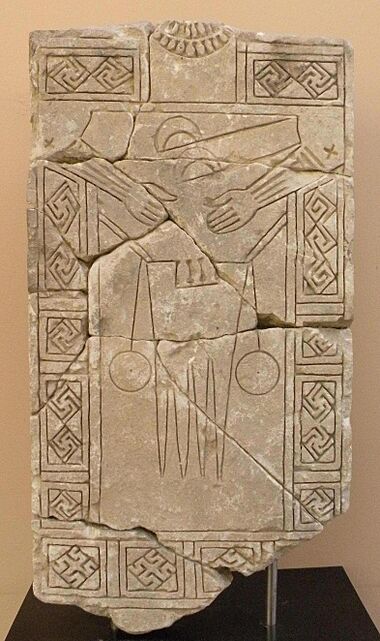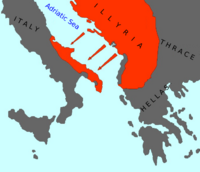Iapygians facts for kids
The Iapygians (pronounced Eye-ah-PIJ-ee-ans) were an ancient people who lived in a region of southeastern Italy called Iapygia. Today, this area is known as Apulia. They spoke an Indo-European language and lived there from about 1000 BC until the 1st century BC.
The Iapygians were divided into three main groups: the Daunians, the Peucetians, and the Messapians. Over time, the Romans slowly took over their lands. By the early 1st century BC, the Iapygians became part of the Roman Republic. They eventually adopted Roman culture and the Latin language.
Contents
What's in a Name?
The ancient Greeks in the 5th century BC called this region Iapygía. They called the people Iápyges. This name was probably what the Iapygians used for themselves.
Sometimes, ancient writers used "Iapygians" and "Messapians" to mean the same thing. Roman writers also called them Apuli in the north, Poediculi in the middle, and Sallentini or Calabri in the south. These different names show that the Iapygian groups might have changed over time. By the 3rd century BC, people usually divided them into three main groups: the Daunians in the north, the Peucetians in the middle, and the Messapians in the south.
Where Did They Live?
Iapygia, which is modern-day Apulia, was located in the southeastern part of Italy. It stretched between the Apennine Mountains and the Adriatic Sea.
The northern part of the region had a large mountain called Monte Gargano. This area was mostly covered in forests and not good for farming. South of Gargano was a big flat plain called the Tavoliere delle Puglie. This plain had sandy soil but also several rivers. In ancient times, it was great for growing grains and especially for sheep grazing in winter. The Ofanto River formed the southern edge of this plain.
Central Iapygia had the Murge Plateau. This area had few rivers. The western part was mainly for grazing sheep. Closer to the sea, the land was better for farming, likely for grains.
The Salento peninsula in the south had a more varied landscape, but still no rivers. People grew olives here before the Romans arrived. Several Greek colonies were on the coast of the Gulf of Taranto. These included Taras, founded in the late 8th century BC, and Metapontion, founded in the late 7th century BC. These Greek cities were close to the Messapians.
Culture and Lifestyle
What Language Did They Speak?
The Iapygians spoke a language called 'Messapic'. It was an Indo-European language but not an Italic one, like Latin. Messapic was written using a form of the Greek alphabet. We have records of this language from the mid-6th to the late-2nd century BC. Some experts think 'Iapygian languages' is a better term for all the dialects, and 'Messapic' should only refer to the language in the Salento peninsula.
Messapic is related to Albanian. These languages are part of a larger group often called "Balkan Indo-European."
During the 6th century BC, the Messapians and Peucetians were influenced by Greek culture, especially from the nearby city of Taras. This is when they started using writing. Another big wave of Greek influence happened in the 4th century BC. This time, it also affected the Daunians.
Messapic was in contact with Italic languages like Oscan. Over time, some areas saw a mix of Oscan and Iapygian people. When the Romans started building colonies in southern Italy, Latin also became common. So, during the Roman period, people in Iapygia often spoke and wrote Messapic, Greek, Oscan, and Latin. Many people in the Salento peninsula probably spoke both Greek and Messapic.
What Was Their Religion Like?
The Iapygians' religion was a mix of their own ancient beliefs and Greek ideas. The Roman conquest probably sped up the Greek influence. For example, they worshipped Aphrodite and Athena as Aprodita and Athana.
They also had their own gods. These included Zis (a sky-god), Menzanas (lord of horses), Venas (desire), and Taotor (the people). Some evidence shows they sacrificed horses to Zis Menzanas. They also believed in the healing powers of waters at a place dedicated to the god Podalirius.
People also used cave sanctuaries along the coast. In the Grotta Porcinara sanctuary, both Messapian and Greek sailors wrote their promises on the walls.
How Did They Dress?
The Iapygian people were known for their fancy clothes. By the 7th century BC, Daunian nobles wore very decorated outfits and lots of jewelry. This continued into later times. Pictures show Iapygians with long hair, wearing short tunics with detailed fringes. Young women wore long tunics belted at the waist, often with a headband. For special events, women in central Iapygia wore a unique mantle over their heads, which still showed their headband.
How Did They Bury Their Dead?
Iapygian burial customs were different from their neighbors. While other Italic peoples buried adults outside their towns, Iapygians buried their dead both inside and outside their settlements. Women sometimes had weapons or armor buried with them, but usually, these items were for men.
Until the late 4th century BC, Daunians and Peucetians often buried bodies in a curled-up position, like a baby in the womb. This might have symbolized the soul's rebirth. Messapians, however, laid their dead out straight, like other Italic peoples. After the 3rd century BC, straight burials became more common in Daunia and Peucetia, but the older custom lasted in some areas.
A Look at Their History
Where Did They Come From?
Most scholars believe that the Iapygians were southern Illyrians. They likely moved from the Western Balkans to southeastern Italy around the early 1000s BC. This idea is supported by ancient writings and archaeological finds.
Before the Romans Arrived
The Iapygians probably arrived in Italy from the eastern coast of the Adriatic Sea starting around the 11th century BC. They mixed with the people already living there, including Italic and Mycenean cultures. This mixing gave the region its unique culture and language. The three main Iapygian groups – Daunians, Peucetians, and Messapians – shared a similar culture at first. But after the 8th century BC, they started to become more distinct.
Contact between the Messapians and Greeks grew stronger after the late 8th century BC. This was when the Greek city of Taras was founded. Before this, Mycenaean people had already visited the area. For a while, Iapygia was not under Greek influence, and the Iapygians mostly avoided other Greek colonies. However, in the 6th century BC, Messapia and Peucetia were influenced by Greek culture, especially from Taras.
The relationship between the Messapians and the people of Taras became difficult. They had several fights starting in the early 5th century BC. After two victories for Taras, the Iapygians won a major battle. This defeat caused the government in Taras to change from an aristocracy (rule by nobles) to a democracy (rule by the people). It also made relations between Greeks and Iapygians difficult for about 50 years. They only started to rebuild their relationship in the late 5th and 6th centuries BC. A second major wave of Greek influence happened in the 4th century BC, this time also affecting the Daunians.
The Roman Takeover
The Romans began conquering Iapygia in the late 4th century BC. They first took control of cities like Canusium and Teanum Apulum. This helped Rome gain power across the whole Italian peninsula. The Romans used their control in Iapygia to limit the power of the Samnites, another Italian people. By the early 3rd century BC, Rome had set up two important colonies, Luceria (314 BC) and Venusia (291 BC), near the border of Iapygia and Samnium.
How They Organized Their Society
In early times, Iapygian homes were small groups of huts spread out across the land. This was different from the later Greco-Roman idea of large cities. People in these rural areas would gather to make decisions, celebrate, practice their religion, and defend themselves.
From the 6th century BC onwards, these scattered settlements started to become more organized. The larger ones grew into towns. They gained the ability to build stone defensive walls and even make their own coins. This showed that they were becoming more like cities and gaining political independence.
According to the ancient writer Thucydides, some Iapygian communities were ruled by powerful individuals in the late 5th century BC. By the end of the 4th century BC, a few of these settlements had become large, fortified towns. They likely saw themselves as independent city-states. Some northern cities seemed to control large areas during this time. Arpi, which had the biggest earth walls in Iapygia during the Iron Age, and Canusium, whose land probably stretched across the Ofanto River, grew into strong regional powers.
This system, where a few powerful city-states competed for resources, likely led to frequent wars among the different Iapygian groups. They also had conflicts with outside communities.
How They Fought
Items found in graves and warriors shown on ancient vase paintings tell us about Iapygian warfare. They often fought with little armor, usually just a shield. Sometimes they wore a leather helmet or a jerkin (a type of jacket), and rarely a breastplate. Their main weapon was the thrusting spear, followed by the javelin. Swords were not very common. Bronze belts were often found in warrior graves.
Pictures on red-figure vases also show that the different Iapygian communities often fought each other. They would take prisoners of war to be ransomed or sold into slavery.
Their Economy
Archaeological evidence suggests that transhumance was practiced in Iapygia before the Romans. This means that shepherds moved their sheep between different pastures depending on the season. Large areas of the region were used for grazing these sheep.
Weaving was an important activity in the 5th and 4th centuries BC. The wool textiles they made were probably sold in the Greek colony of Taras. In winter, Iapygian pastoralists (shepherds) likely took their sheep to the Tavoliere plain. The weaving industry was already well developed there by the 7th or early 6th century BC. This is shown by pictures of weavers at work on ancient stone carvings.
Images for kids
See also
- List of ancient Illyrian peoples and tribes
- List of ancient peoples of Italy






